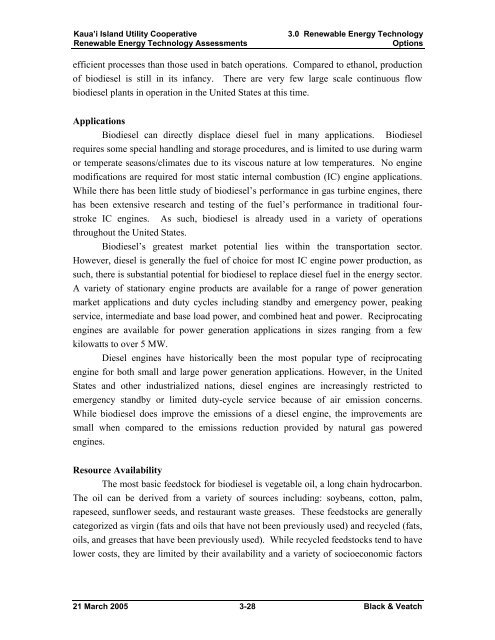Renewable Energy Technology Assessments - Kauai Island Utility ...
Renewable Energy Technology Assessments - Kauai Island Utility ...
Renewable Energy Technology Assessments - Kauai Island Utility ...
You also want an ePaper? Increase the reach of your titles
YUMPU automatically turns print PDFs into web optimized ePapers that Google loves.
Kaua’i <strong>Island</strong> <strong>Utility</strong> Cooperative<br />
<strong>Renewable</strong> <strong>Energy</strong> <strong>Technology</strong> <strong>Assessments</strong><br />
3.0 <strong>Renewable</strong> <strong>Energy</strong> <strong>Technology</strong><br />
Options<br />
efficient processes than those used in batch operations. Compared to ethanol, production<br />
of biodiesel is still in its infancy. There are very few large scale continuous flow<br />
biodiesel plants in operation in the United States at this time.<br />
Applications<br />
Biodiesel can directly displace diesel fuel in many applications. Biodiesel<br />
requires some special handling and storage procedures, and is limited to use during warm<br />
or temperate seasons/climates due to its viscous nature at low temperatures. No engine<br />
modifications are required for most static internal combustion (IC) engine applications.<br />
While there has been little study of biodiesel’s performance in gas turbine engines, there<br />
has been extensive research and testing of the fuel’s performance in traditional fourstroke<br />
IC engines. As such, biodiesel is already used in a variety of operations<br />
throughout the United States.<br />
Biodiesel’s greatest market potential lies within the transportation sector.<br />
However, diesel is generally the fuel of choice for most IC engine power production, as<br />
such, there is substantial potential for biodiesel to replace diesel fuel in the energy sector.<br />
A variety of stationary engine products are available for a range of power generation<br />
market applications and duty cycles including standby and emergency power, peaking<br />
service, intermediate and base load power, and combined heat and power. Reciprocating<br />
engines are available for power generation applications in sizes ranging from a few<br />
kilowatts to over 5 MW.<br />
Diesel engines have historically been the most popular type of reciprocating<br />
engine for both small and large power generation applications. However, in the United<br />
States and other industrialized nations, diesel engines are increasingly restricted to<br />
emergency standby or limited duty-cycle service because of air emission concerns.<br />
While biodiesel does improve the emissions of a diesel engine, the improvements are<br />
small when compared to the emissions reduction provided by natural gas powered<br />
engines.<br />
Resource Availability<br />
The most basic feedstock for biodiesel is vegetable oil, a long chain hydrocarbon.<br />
The oil can be derived from a variety of sources including: soybeans, cotton, palm,<br />
rapeseed, sunflower seeds, and restaurant waste greases. These feedstocks are generally<br />
categorized as virgin (fats and oils that have not been previously used) and recycled (fats,<br />
oils, and greases that have been previously used). While recycled feedstocks tend to have<br />
lower costs, they are limited by their availability and a variety of socioeconomic factors<br />
21 March 2005 3-28 Black & Veatch
















